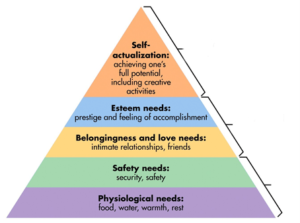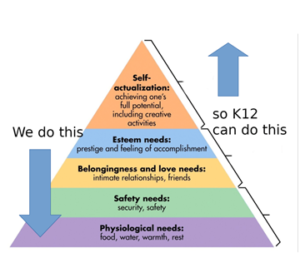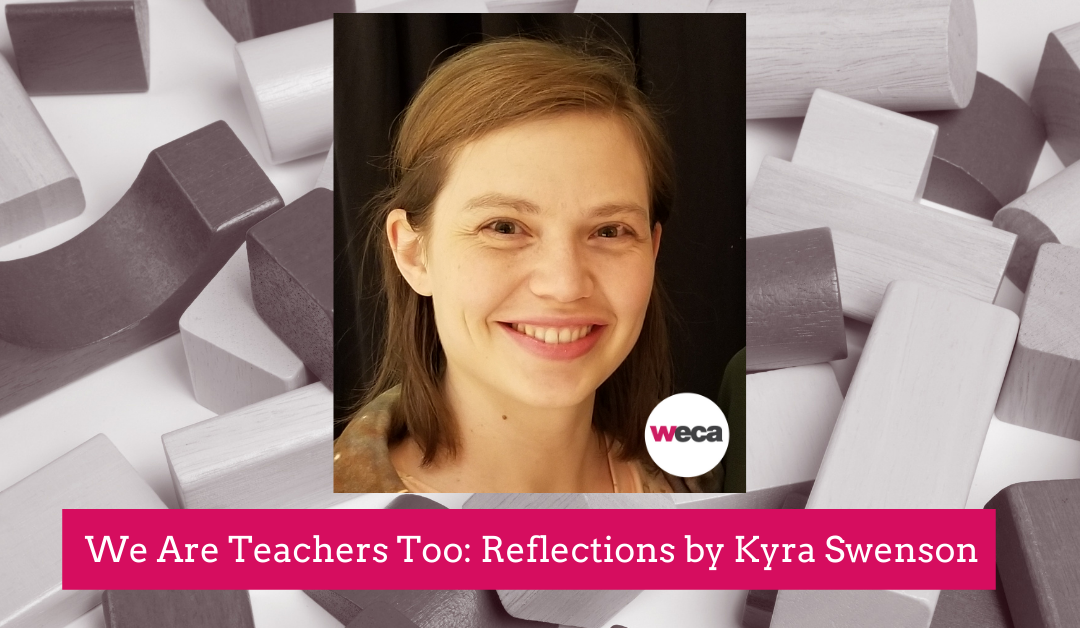It began with idle small talk at a friend’s party. But that’s always how it begins.
“I’m a Realtor, what do you do?”
“I’m a teacher.”
“Oh, that’s such a rewarding job! My niece is in second grade. What grade do you teach?”
“I teach one-year-olds.”
*record scratch *
“…wait, I thought you said you were a teacher. What do you teach one-year-olds?”
I’m certain I’m not the only early childhood professional to ever have this conversation. And in the intervening years, I’ve had other variations on the theme. Like when, at my daughter’s birthday party, one of the fathers (a parent at my center no less) asked me “So, after daycare, what’s your next career move?”, as if somehow early ed could only be a stopover towards a real career. Or there is the ever-pervasive, perpetually annoying “I wish I could play with babies all day!”. Because play is the only thing we do. We don’t lesson plan, we don’t act as coaches and mentors for the families in our care, and we certainly aren’t required to continually update our learning and knowledge base (spoiler alert: we do, we do, and we are)I mean, their just babies, right?
This is one of the primary challenges of our field. The community at large doesn’t know how to place us. Right now we are still relegated to the service industry: The U.S. Bureau of Labor Statistics still places childcare workers (at least they’ve stopped calling us “daycare”) in the category of personal care and services, right along with dog trainers and hairstylists. We provide a service: we keep kids safe while parents work. And that’s the end of it.
This shows a fundamental lack of understanding of how young children learn. Our work, in fact, is to care for and educate young children, just as public school teachers do. Children birth to eight (yep, early childhood goes through second grade, folks) don’t learn like adults. They don’t even learn like nine-year-olds. So, let’s talk about how they do learn.
 The picture on the right should be familiar to most psych 101 students: Maslow’s Hierarchy of Needs. In case you aren’t familiar with the theory, humans have certain basic needs that have to be met before any type of higher thinking or learning can be done. Think of the Snicker’s “You’re not you when you’re hungry” ad campaign. At the very bottom of the pyramid are the physiological needs: eating, sleeping, avoiding the extreme cold of a Wisconsin winter. Above that is safety, then a sense of belonging, then esteem needs. At the very top of the pyramid, accessible only when all other needs are met, is “self-actualization”, defined as “potential through creativity, independence, spontaneity, and a grasp of the real world.”
The picture on the right should be familiar to most psych 101 students: Maslow’s Hierarchy of Needs. In case you aren’t familiar with the theory, humans have certain basic needs that have to be met before any type of higher thinking or learning can be done. Think of the Snicker’s “You’re not you when you’re hungry” ad campaign. At the very bottom of the pyramid are the physiological needs: eating, sleeping, avoiding the extreme cold of a Wisconsin winter. Above that is safety, then a sense of belonging, then esteem needs. At the very top of the pyramid, accessible only when all other needs are met, is “self-actualization”, defined as “potential through creativity, independence, spontaneity, and a grasp of the real world.”
Learning, or at least what we mean for older children and adults, only happens in that last small triangle. The rest of it is what we as early childhood educators (and their parents!) spend the first vital years of a child’s life teaching. When I feed a baby a bottle and put them to bed, I am doing more than just calming them, I am teaching them that their physiological needs will be met. Later, when they start to point, babel and try to make words, I am doing more than just teaching them to talk. From me, they are learning that those needs can be met in a socially acceptable manner. When I prevent one child from biting another, I am not only preventing injury, I am teaching that I will keep them, and their friends, safe from harm. When I post pictures of a child and her classmates around the room, I am doing more than decorating, I am teaching them that they belong and are important to our community. And while stair climbing and bead stringing are important for their fine and gross motor skills, with each new challenge, I am really teaching them that they can confidently approach and attain new levels of skills.
 In a school classroom, a child that has had all these “lessons” in their early years will be able to calmly ask for a snack, knowing that their physical needs will be met by caring adults. They will be able to take risks, trusting adults around them to keep them safe. They will refrain from harming others, knowing those same adults won’t allow their friends to be hurt either. They will be eager to participate, knowing that they belong in a learning community. And they will persist through challenges knowing that they are capable. Basically, through our caring labor, they will be ready to do all the traditional learning expected from kindergarten onward.
In a school classroom, a child that has had all these “lessons” in their early years will be able to calmly ask for a snack, knowing that their physical needs will be met by caring adults. They will be able to take risks, trusting adults around them to keep them safe. They will refrain from harming others, knowing those same adults won’t allow their friends to be hurt either. They will be eager to participate, knowing that they belong in a learning community. And they will persist through challenges knowing that they are capable. Basically, through our caring labor, they will be ready to do all the traditional learning expected from kindergarten onward.
Now, with a better understanding of how young children learn, let’s return to our BLS definition of child care as part of the service industry. To play devil’s advocate a moment, one might argue that the definition is still correct. Child care still does provide a service of safety and security, it just so happens that learning occurs during that time. Does the categorization matter? Is how we are defined really that important? It is because how we are defined is directly related to how we are funded.
As a society, we agree (well, we mostly agree) that public education is a key infrastructure piece. It creates the stable, well-educated society that our economy relies on. Given that, it deserves some level of public funding (how much is something we can’t seem to agree on). But care, the basic safety and well-being of our children, that’s different. Whether it should be or not, children’s care is seen as a private issue, and should therefore be privately funded. But that private funding is what has saddled us with the unstable, unreliable, and fundamentally unsustainable child care system we have currently. It doesn’t work, in fact has never worked, because too much is riding on the first years of life. If we are able to bring to light the vital learning that happens in these early years, the foundational skills upon which all other learning will be built throughout the human lifetime, we can bring child care out of the realm of service and into education. We can finally be seen as what we are-a public good in our own right, worthy of the same level of resources that we give to other infrastructure in our society.
For young children, care is education, and education is care. The two are inexorably linked. We must work to be seen as a vital part of our education system because let’s face it when we give a hug, show a smile, or read a story, we are teachers too.
Kyra Swenson, is the Co-founder, Wisconsin Early Childhood Action Needed and has 12 years of experience in the early care and education field.

